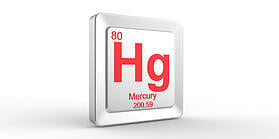The Gold Rush Part V: Sources of Mercury
 Part four of our mercury blog series covered the effects of mercury exposure on humans. In the final part of our series, we will focus on the sources of mercury, and briefly highlight the existing regulation designed to stop mercury from damaging the environment, wildlife ecosystems, and human lives.
Part four of our mercury blog series covered the effects of mercury exposure on humans. In the final part of our series, we will focus on the sources of mercury, and briefly highlight the existing regulation designed to stop mercury from damaging the environment, wildlife ecosystems, and human lives.
Mercury sources can be classified as natural versus man-made (anthropogenic). Anthropogenic mercury emission can further be broken down into historic and modern emissions. Because mercury emissions can reside in the environment for thousands of years (there is uncertainty on its lifespan), recognizing both historic and modern mercury emission sources is a growing trend (to be discussed in the third blog). Because mercury can be recycled in the environment historical emissions can join with modern emissions to form what has been called a “global mercury reservoir.”[i]
Natural Sources
Mercury in comparison to other elements within the earth’s crust is an extremely rare. Despite its rarity, natural deposits of mercury exist in extraordinary concentration due to its inability to blend with other elements in the earth’s crusts.[ii] Although sequestered within the earth’s crust, mercury can still pose a threat through absorption by plants or washing into bodies of water. While Volcanoes, forest fires, cinnabar ore, and fossil fuels are natural sources of mercury, a majority of global mercury emissions are Anthropogenic (produced by human activity)
Anthropogenic
Mercury has been mined and used by mankind from some of the earliest civilizations including the Egyptians, Greeks, Romans, and ancient Chinese[iii], and has been employed in numerous uses. Today, modern mercury emitters generally come in the form of large-scale industries with amplified impact such as landfills, coal-fired power plants, waste incinerators, steel and cement production, chlorine manufacture and agriculture.[iv]
Anthropogenic mercury emissions can be divided into four large categories:
- Area Sources (e.g. landfills)
- Combustion Processes (e.g. powerplants and boilers)
- Manufacture of metals, alkali and cement (e.g. steel production)
- Other industrial processes[v]
Once emitted, the mercury gases and particulates are transported globally and eventually deposited back to the earth, by a process known as atmospheric deposition. Once deposited, the mercury collects in soil, waterbodies, sediments, and surface water.[vi]
Regulation
- On March 15, 2005, the EPA issued the Clean Air Mercury Rule “which creates performance standards and establishes permanent, declining caps on mercury emissions. The Clean Air Mercury Rule marks the first time EPA has ever regulated mercury emissions from coal-fired power plants.”[vii]
- Other regulations on mercury were also put in place including
- The Mercury Export Ban Act of 2008, which removed “a significant amount of mercury from the global market”, and was directed at the export of mercury used globally in “artisanal and small-scale gold mining.”
- The Mercury-Containing and Rechargeable Battery Management Act of 1996 that “phases out the use of mercury in batteries, and provides for the efficient and cost-effective disposal of nickel cadmium (Ni-Cd) batteries, used small sealed lead-acid (SSLA) batteries, and certain other regulated batteries.
- The Clean Water Act, which adopted water quality standards for states. The standards specify mercury levels that “must be met to protect human health, fish and wildlife” and prohibit the discharge of mercury into waters without permit.
- The Safe Drinking Water Act which set standards for public water systems, limiting mercury levels in drinking water.
- A plethora of other regulations and standards have been put in place by the USEPA with a concerted effort to regulate and monitor mercury contamination and mitigate risks. [viii]
Conclusion
A November BBC 2013 article described mercury perfectly, “Mercury is the quixotic bad boy of the periodic table - exquisitely beautiful, but deadly. The ancients believed it was the "first matter" from which all other metals were formed. Yet it is now in such disfavour that an international treaty exists to curb its use.”[ix]
We know that roughly half of all the mercury released into the environment comes from natural sources. The other half comes from mankind. As we read in part one of our series, we are still dealing with the effects of heavy gold mining from nearly two hundred years ago, and the release of mercury from manmade technology and practices has only increased. It is the mankind’s half of the environmental mercury deposits that the world is trying to stop as we learn more and more about the damaging impact this “beautiful, but deadly” metal has on humans and other organisms.
If you would like to download the 5 part series of "All About Mercury" click the link below
[ii] Wikipedia. http://en.wikipedia.org/wiki/Mercury_(element)
[iii] ibid
[iv] Mercury Contamination in Fish - Know Where It’s Coming From. Natural Resources Defense Council. http://www.nrdc.org/health/effects/mercury/sources.asp
[v] University of Wisconsin-Eau Claire - People Pages. Mercury in the Environment and Water Supply.
[vi] Tewalt, Susan J; Bragg, Linda J; Finkelman, Robert B. Mercury in U.S. Coal -- Abundance, Distribution, and Modes of Occurrence; Publications - Fact Sheet 95-01, Version 1.0. U.S. Geological Survey. http://pubs.usgs.gov/fs/fs095-01/
[vii] U.S. Environmental Protection Agency. http://www.epa.gov/hg/regs.htm
[viii] ibid
[ix] http://www.bbc.com/news/magazine-25130770

